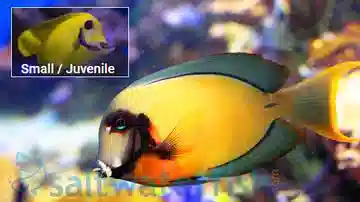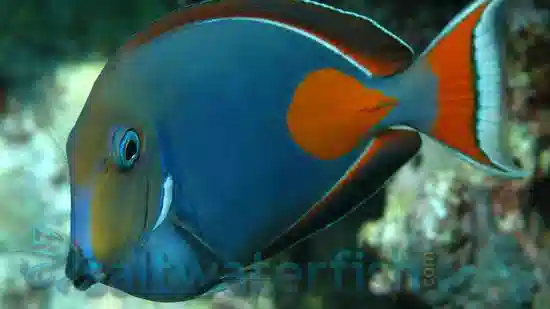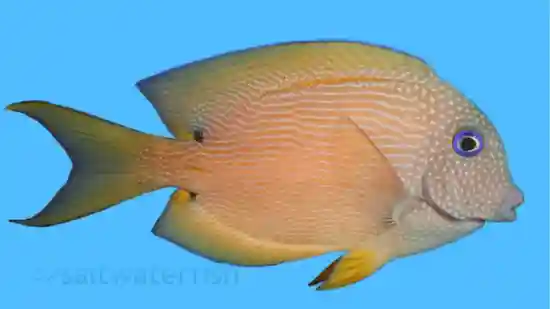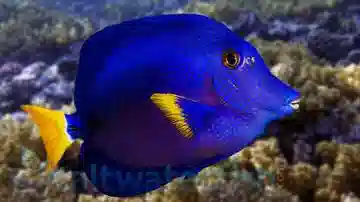Purple Tang - Red Sea
Zebrasoma xanthurum
(0 Reviews)

Purple Tang - Red Sea
Zebrasoma xanthurum
(0 Reviews)
{{ item.name }}
Size: {{ item.extra_field_3 }}
${{ getFormattedPrice(item.saleprice) }} ${{ getFormattedPrice(item.price) }}
To join the waiting list, click here
Free Shipping
With
$199.00
or more in Marine Life.
More details...
Purple Tang - Red Sea Care Facts
| Care Level: | Easy |
|---|---|
| Temperament: | Bold |
| Reef Safe: | Yes |
| Diet: | Herbivore |
| Origin: | Red Sea |
| Acclimation Time: | 3+ hours |
| Coral Safe: | Yes |
| Invertebrate Safe: | Yes |
| Minimum Tank Size: | 100 Gallons |
The Purple Tang is commonly referred as the Yellowtail Sailfin Tang, Yellowtail Surgeonfish, and the Blue Surgeonfish. It has a purple colored body with yellow tail and yellow accents on the pectoral fins. The Purple Tang requires lots of free-swimming space and plenty of potential hiding spots. The Purple Tang can be very aggressive and do not get well with other tangs of the genus Zebrasoma. It feeds on meaty foods, it is important to offer them plenty of marine-based seaweed and algae as well.
Introducing the Purple Tang (Zebrasoma xanthurum)
Explore the striking and captivating addition that is the Purple Tang (Zebrasoma xanthurum), renowned for its regal beauty and graceful movements in saltwater marine aquariums. This article delves into various facets of the Purple Tang, including its natural habitat, reef compatibility, size, lifespan, dietary preferences, aquaculture potential, temperament, suitable tank mates, tank requirements, water conditions, alternative common names, compatible tank mates, and the benefits of acquiring Purple Tangs from Saltwaterfish.com. Discover why this species is a prized choice among marine enthusiasts.
Habitat and Distribution:
The Purple Tang is indigenous to the Indo-Pacific region, spanning from the Red Sea to the western Pacific Ocean. It thrives amidst the intricate ecosystems of coral reefs, making it a sight to behold in the confines of a well-maintained aquarium.
Reef Compatibility:
The Purple Tang is generally considered reef safe, with a propensity for grazing on algae rather than coral polyps. However, providing a variety of algae-based foods is recommended to support their dietary needs and minimize any coral-related interactions.
Size and Lifespan:
This tang species can reach a length of approximately 9 to 10 inches (23 to 25 cm), gracing your aquarium with its regal presence. Under optimal care, Purple Tangs can live for a decade or more.
Diet:
The Purple Tang is primarily herbivorous, requiring a diet rich in algae and vegetable matter. A mix of high-quality marine pellets, seaweed sheets, and fresh greens ensures their nutritional well-being.
Aquaculture Potential:
Purple Tangs are available in the aquarium trade, with both wild-caught and aquacultured specimens accessible. Opting for aquacultured Purple Tangs supports sustainable practices and contributes to the conservation of wild populations. Saltwaterfish.com has a constant supply of aquacultured Purple Tangs, reasonably priced from one of the foremost aquaculture facilities in the USA. Check them out here.
Temperament:
Purple Tangs are known for their spirited personalities and territorial behaviors. Introducing them to the aquarium last is advisable to minimize potential aggression towards new tank mates.
Suitable Tank Mates:
Angelfish (e.g., Koran Angelfish): Certain angelfish species with differing colors and body shapes can coexist harmoniously with Purple Tangs.
Blennies (e.g., Midas Blenny): Peaceful blennies can share the tank with Purple Tangs, adding diversity to the ecosystem.
Wrasse (e.g., Six Line Wrasse): Peaceful wrasse species can create an engaging and dynamic tank environment alongside Purple Tangs.
Hawkfish (e.g., Flame Hawkfish): Hawkfish with distinctive characteristics can cohabitate with Purple Tangs, enhancing the visual appeal of the aquarium.
Basslets (e.g., Royal Gramma): Basslets with contrasting behaviors and coloration can coexist with Purple Tangs, contributing to the overall aesthetic of the tank.
Tank Requirements and Water Conditions:
A well-equipped aquarium with ample swimming space is vital for the well-being of Purple Tangs. A tank size of at least 100 gallons is recommended to provide room for their active swimming habits. Consistent water quality, proper filtration, and optimal lighting are crucial to support their health and vibrant appearance.
Why Choose Saltwaterfish.com:
Sourcing Purple Tangs from Saltwaterfish.com offers numerous advantages. Their commitment to ethical and sustainable practices ensures you receive healthy and responsibly sourced specimens. Saltwaterfish.com provides comprehensive information about each species, aiding in well-informed decision-making. With a variety of options, exceptional customer support, and a streamlined purchasing process, Saltwaterfish.com guarantees a smooth and satisfying experience for marine enthusiasts.
In conclusion, the Purple Tang (Zebrasoma xanthurum) is a captivating and regal addition to saltwater marine aquariums. Its vibrant coloration and elegant movements make it a cherished member of marine ecosystems. By providing suitable tank arrangements and selecting compatible tank mates, enthusiasts can appreciate the beauty and vibrancy of these captivating tangs in their aquatic sanctuaries. When considering the acquisition of this exceptional species, choosing Saltwaterfish.com ensures a reliable and ethical source that prioritizes marine life's health and well-being. With proper care and attention, the Purple Tang can become a breathtaking and iconic centerpiece in any saltwater aquarium, enriching the allure and elegance of the underwater world.
Nice fish
Reviewed by: Luke Mann on Feb. 16, 2025
Exactly as expected
Reviewed by: Scott Olson on Sept. 24, 2024
Reviewed by: Pepper Brandon on Sept. 24, 2024
Loving life healthy eating well
Reviewed by: Robert Johnson on Sept. 5, 2024
Reviewed by: Travis Ross on Sept. 3, 2024
Reviewed by: Harold Hoffman on May 2, 2024
My favorite fish
Reviewed by: Jose Acosta on April 30, 2024
Beautiful healthy fish.
Reviewed by: Dan Roberts on Dec. 5, 2023
Reviewed by: Joseph Fortini on Nov. 26, 2023
The specimen I got was pretty small; not what I expected from what was supposed to be a 2-3 in. fish. But it arrived in great health, so I’ll rate it with an A-
Reviewed by: Gary Nelson on Nov. 26, 2023
Even with delays in fedex’s shipping this fish arrived alive and looking beautiful!
Reviewed by: Devlin Duvenhage on Nov. 26, 2023
Reviewed by: Jay Joiner on Nov. 9, 2023
Reviewed by: Christopher Farah on Nov. 7, 2023
Reviewed by: Richard Kenney on Nov. 6, 2023
Reviewed by: Chris Brault on Nov. 5, 2023
Reviewed by: Stacey Miller on Oct. 31, 2023
Smaller than I expected but other then that excellent
Reviewed by: Reynaldo Sosa on Oct. 31, 2023
Price is still high, you could move more inventory and make more money if you sold these at a low price. Out compete your competitors; dominate the market
Reviewed by: Gary Nelson on Oct. 30, 2023
Reviewed by: Michael Reno on Oct. 24, 2023
He came out swimming and has adapted well to his new home. Very happy
Reviewed by: Rik Miller on Oct. 22, 2023
He superl little guy
Reviewed by: Debbie Konechney on Oct. 18, 2023















